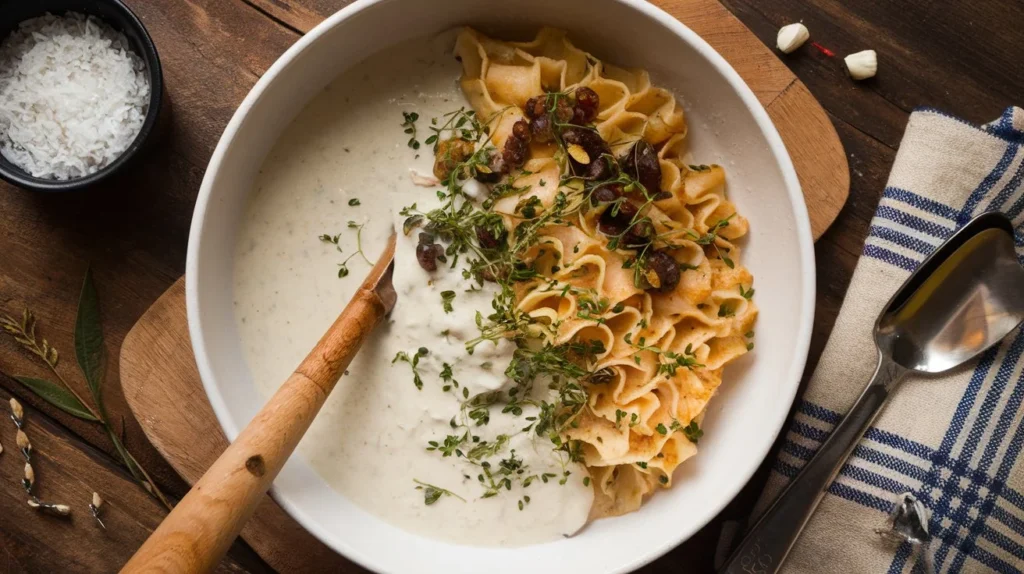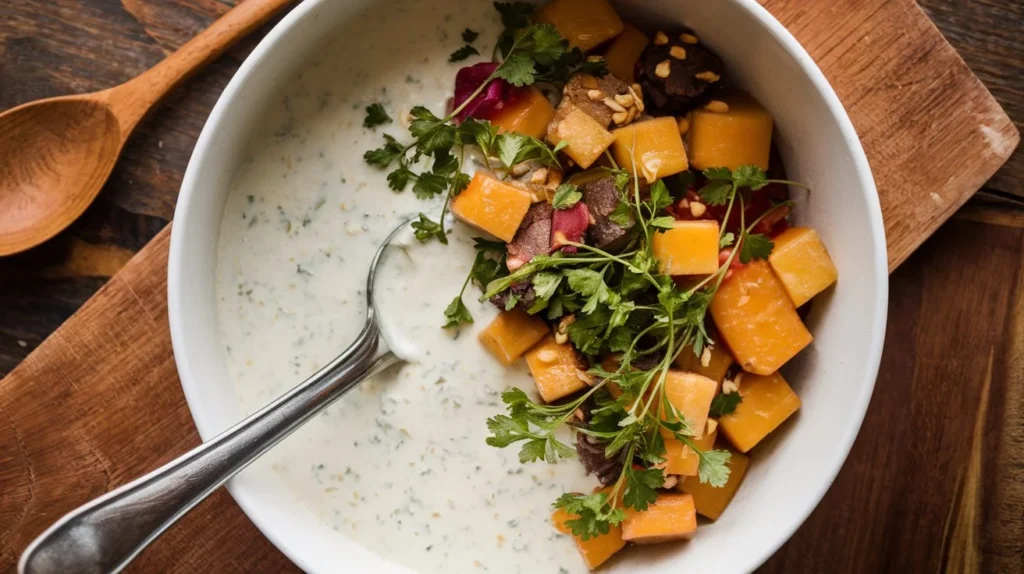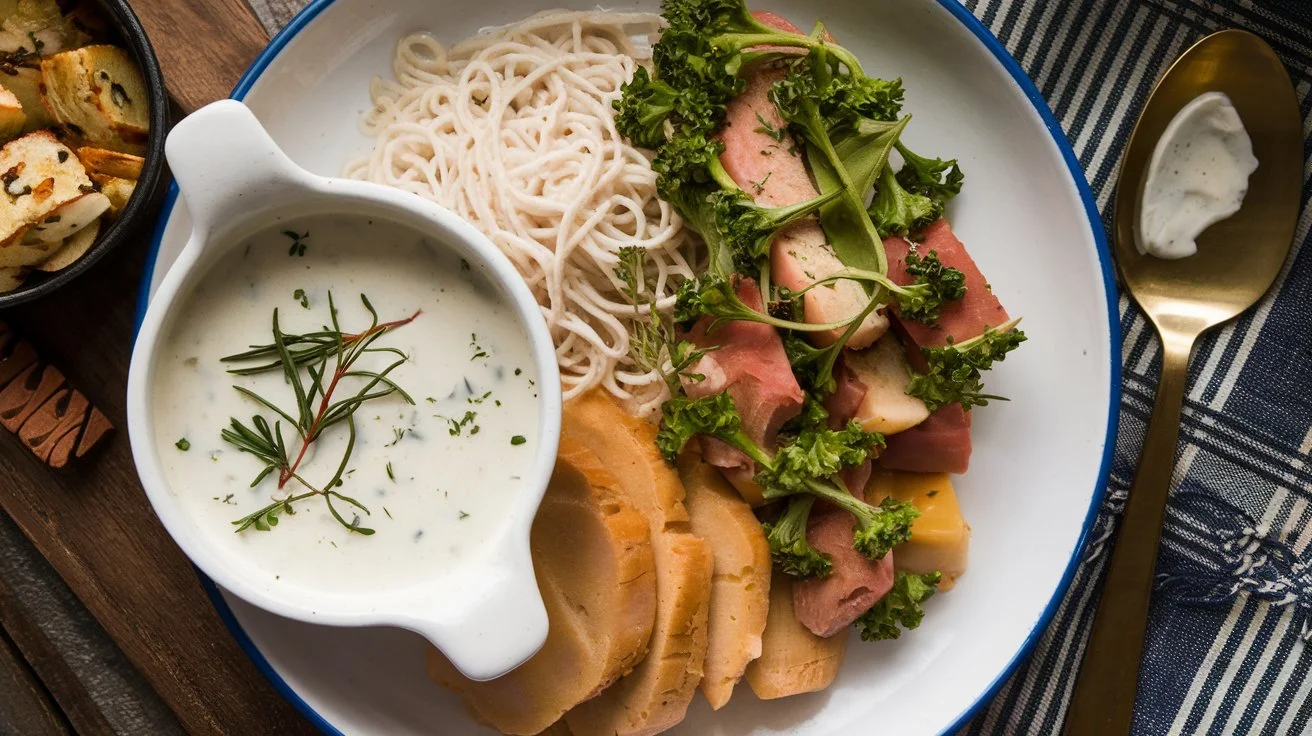Introduction
If there’s one thing that embodies Southern comfort food, it’s white gravy. This rich, creamy sauce is a kitchen essential, beloved for its smooth texture and flavorful taste. Whether you’re drizzling it over flaky biscuits, smothering it on crispy chicken-fried steak, or pouring it on mashed potatoes, white gravy takes any meal to the next level. But here’s the best part — it’s incredibly simple to make at home with just a few ingredients!
In this ultimate guide, we’ll walk you through everything you need to know about white gravy — from its history and essential ingredients to step-by-step instructions for making it from scratch. You’ll also learn tips to avoid common mistakes, creative serving ideas, and even how to store it properly. By the end, you’ll be a gravy-making pro, ready to impress your family or guests at any meal.
Introduction to White Gravy
What Is White Gravy?
When you hear the term gravy, you might instantly picture a creamy, pepper-flecked sauce poured over fresh biscuits. And you’d be absolutely right! White gravy, sometimes called country gravy or cream gravy, is a smooth, white-colored sauce made from a simple base of fat, flour, and milk. It’s seasoned with salt, pepper, and sometimes a dash of cayenne for a little extra kick.
Unlike brown gravy, which is made using meat drippings and broth, white gravy uses milk as its liquid base. This gives it its signature creamy, velvety texture. It’s a staple in Southern cuisine, but it has found its way into kitchens across the country. The best part? It pairs perfectly with so many dishes, from fried chicken to mashed potatoes.
The History of White Gravy
Believe it or not, the roots of white gravy can be traced back to classic French cooking, particularly the beloved béchamel sauce — one of the five “mother sauces” in French cuisine. Béchamel is made by whisking milk into a roux (a mixture of flour and fat), which is essentially the same method used to make gravy.
When European settlers arrived in America, they adapted their cooking methods to the ingredients available. Butter, flour, and milk were easy to source, and before long, white gravy became a staple in Southern kitchens. By the 19th century, biscuits and gravy were already a household favorite, often served as a hearty breakfast to fuel long workdays.
Over time, white gravy became a cherished part of Southern cuisine. Today, you’ll find it served at diners, country kitchens, and breakfast tables all across America. Its nostalgic flavor, creamy texture, and versatility have made it a timeless classic.
Benefits of Learning to Make White Gravy
Why should you master the art of making white gravy? Here’s a list of reasons to get you excited:
- Cost-Effective: Homemade gravy costs less than store-bought versions and tastes way better.
- Flavor Control: You control the salt, spices, and thickness to suit your taste buds.
- Versatility: This isn’t just for biscuits — white gravy works on fried chicken, potatoes, and more.
- Easy to Make: With only a few simple ingredients, anyone can make it, even first-time cooks!
When you can make white gravy from scratch, you’ll never have to rely on packaged mixes again. Plus, you’ll impress everyone at the table with your culinary skills!
How to Make Gravy from Scratch
Essential Ingredients for White Gravy
To make the perfect white gravy, you only need a handful of kitchen staples. But each ingredient plays a crucial role in creating that smooth, flavorful texture we all love. Here’s what you’ll need:
- Fat: This can be butter, sausage drippings, or even oil. Each option adds a unique flavor, but if you want that authentic country-style taste, sausage drippings are a game-changer. Butter is a great all-purpose option for a mild, creamy taste.
- Flour: The thickening agent that gives gravy its signature consistency. All-purpose flour works best, but you can experiment with alternatives like gluten-free flour if needed.
- Milk: Whole milk is the traditional choice for rich, creamy gravy. However, you can use 2%, skim milk, or even plant-based milk for a lighter option. Whole milk delivers the creamiest texture, but 2% works just as well.
- Salt and Pepper: Salt enhances flavor, while black pepper adds that classic kick. For an extra boost, try using freshly ground pepper for a bolder taste.
- Optional Seasonings: Want to take it up a notch? Add a pinch of cayenne pepper for spice, a sprinkle of garlic powder for depth, or fresh herbs like thyme for a fragrant twist.
These ingredients may seem simple, but together, they create a masterpiece of flavor and texture. Now, let’s move on to how to put them all together.
Step-by-Step Instructions for Making Gravy

Making white gravy from scratch is simple and satisfying. Follow these quick steps for smooth, creamy perfection every time.
Prepare the Ingredients and Equipment
Pre-measure ingredients and have your tools ready. You’ll need a whisk, skillet, and spatula or spoon. This setup makes the process seamless and stress-free.
Heat the Fat and Create the Roux
Heat 1/4 cup of butter, oil, or sausage drippings in a skillet over medium heat. Add 1/4 cup of flour and whisk constantly to form a smooth, golden roux. Cook for 2-3 minutes until lightly browned, stirring to prevent burning.
💡 Pro Tip: If the roux is dry, add more fat. If it’s greasy, sprinkle in more flour. Aim for a paste-like texture.
Slowly Add Milk While Whisking to Avoid Lumps
Gradually pour in 2 cups of room-temperature milk while whisking. Add it slowly to prevent lumps. Cook and stir until the mixture thickens. If it’s too thick, add a splash of milk; if it’s too thin, cook a bit longer.
💡 Pro Tip: Warm milk works best. Cold milk can create lumps as it hits the hot roux.
Season the Gravy and Adjust Thickness
Once thick, season with salt and pepper. Add onion powder, garlic powder, or cayenne for extra flavor. If too thick, add milk. If too thin, cook a little longer to reduce.
Serve and Enjoy
Pour the hot, creamy gravy over biscuits, fried chicken, or mashed potatoes. Serve immediately and watch everyone dig in!
Common Mistakes to Avoid
Even seasoned cooks run into a few hiccups while making white gravy. Here’s how to avoid the most common pitfalls:
- Lumpy Gravy: Lumps form when the milk is added too quickly, or the roux is cooked incorrectly. To fix this, strain the gravy or blend it with an immersion blender. Prevent lumps by pouring milk slowly and whisking constantly.
- Burnt Roux: A burnt roux can ruin the taste of your gravy. If you see black flecks in the roux, start over. To avoid burning, keep stirring and don’t leave the pan unattended.
- Too Thin or Too Thick: If your gravy is too thin, let it cook longer to reduce. If it’s too thick, stir in a small splash of milk. It’s all about balance.
Tips for Perfect Gravy Every Time
Want to make white gravy like a pro? Here are some game-changing tips:
- Adjust the Thickness: If the gravy is too thick, add milk a tablespoon at a time. If it’s too thin, let it simmer for another minute or two. The perfect consistency is creamy but not gloopy.
- Season Smartly: Salt and pepper are essential, but why stop there? A pinch of cayenne or garlic powder can give your gravy extra depth. Some people even add a splash of broth for added flavor.
- Whisk Like a Pro: Whisking is everything! Use a whisk instead of a spoon to break up flour clumps. If lumps do form, blend it briefly or press it through a fine mesh strainer.
With these foolproof tips, your gravy will always turn out smooth, creamy, and full of flavor. Now that you’ve mastered the process, you’ll never go back to store-bought again.
Serving and Storing White Gravy
Best Dishes to Serve with White Gravy
White gravy is a versatile sauce that elevates any meal. Here are some of the best dishes to pair with it:
Biscuits and Gravy
This classic Southern breakfast staple features fluffy biscuits drenched in creamy, peppery white gravy. It’s hearty, comforting, and absolutely delicious.
Chicken-Fried Steak
A crispy, breaded steak topped with smooth white gravy is the ultimate comfort meal. The contrast between the crunchy coating and creamy sauce is irresistible.
Mashed Potatoes
Mashed potatoes are rich and buttery on their own, but add a drizzle of white gravy and you’ve got a next-level side dish.
Fried Chicken
Instead of hot sauce, try dipping fried chicken into gravy. The creamy texture perfectly balances the crispy chicken’s crunch.
Meatloaf, Pork Chops, and Ham
These savory proteins pair beautifully with gravy, turning any meal into a restaurant-quality experience.
Creative Variations of Gravy
Switch up your classic white gravy with these delicious twists:
Sausage Gravy: Add crumbled, cooked sausage to your gravy for a hearty flavor boost.
Sawmill Gravy: Made thicker with cornmeal for a more rustic, filling texture.
Red-Eye Gravy: A coffee-based gravy with a bold, intense flavor.
Vegetarian White Gravy: Use butter or plant-based oils instead of meat drippings for a delicious vegetarian option.
These creative versions add variety and flair to your standard white gravy.
How to Store and Reheat White Gravy
Storage Methods
- Refrigerate in an airtight container for up to 4 days.
- Freeze in a freezer-safe container for up to 3 months (leave space for expansion).
Reheating Tips
- Stovetop: Reheat on low, stirring frequently. Add milk if it’s too thick.
- Microwave: Heat in 30-second intervals, stirring each time to maintain smoothness.
If your gravy becomes too thick, add a splash of milk. If it’s too thin, simmer it to reduce.
Nutritional Information for White Gravy
Per 1/4 cup serving, traditional white gravy contains:
- Calories: 100-120
- Fat: 7g
- Carbohydrates: 7g
- Protein: 2g
Healthier Options
- Use low-fat milk instead of whole milk.
- Swap butter for olive oil or a neutral oil.
- Use whole wheat flour for more fiber.
With a few ingredient swaps, you can enjoy a healthier, homemade white gravy without sacrificing flavor.
Advanced White Gravy Tips and Troubleshooting

How to Make Gluten-Free White Gravy
You can easily make white gravy gluten-free by swapping all-purpose flour with these alternatives:
Best Gluten-Free Substitutes
- Cornstarch: Mix 1 tbsp cornstarch with 2 tbsp water before adding to gravy.
- Rice Flour: Works just like regular flour but cooks faster.
- Potato Starch or Arrowroot Powder: Thickens quickly, no roux required.
Pro Tips
- Whisk constantly to avoid clumps.
- Cook on low heat and add thickeners gradually for the best consistency.
How to Thicken or Thin White Gravy
Thicken
- Simmer It: Let it cook longer to reduce liquid.
- More Roux: Add a bit of cooked flour and butter mix.
- Cornstarch Slurry: 1 tbsp cornstarch + 2 tbsp water, whisk it in.
How to Thin
- Add Milk or Water: Stir in a splash of liquid to get a smoother consistency.
Simple adjustments like these will give you perfectly thick or thin white gravy every time.
How to Fix Lumpy Gravy
Lumps happen, but they’re easy to fix.
Why It Happens
Lumps form when milk is added too quickly or whisking isn’t thorough.
How to Fix It
- Whisk It: Whisk vigorously to break up clumps.
- Strain It: Pour through a fine mesh strainer.
- Blend It: Use an immersion blender for a smooth finish.
To prevent lumps, add milk slowly and whisk constantly.
How to Make White Gravy Without Milk
If you’re out of milk or need a dairy-free option, try these substitutes:
Best Dairy-Free Substitutes
- Almond Milk: Slight nutty flavor, but smooth texture.
- Soy Milk: Neutral flavor and thick texture.
- Coconut Milk: Extra creamy but slightly sweet.
Flavor and Texture Changes
Each milk adds its own twist, but soy milk is the most neutral. You may need to adjust seasonings to balance sweetness from coconut or almond milk.
How to Add Extra Flavor to Gravy
Elevate your white gravy with bold flavors!
Spices and Seasonings
- Cayenne, Paprika, Garlic Powder: Add spice and depth.
- Onion Powder: Subtle sweetness that enhances taste.
Herbs
- Fresh herbs like thyme, rosemary, and parsley add freshness and aroma.
Broth Boosters
- Replace part of the milk with chicken, beef, or vegetable broth for deeper flavor.
These simple additions turn standard gravy into something extraordinary.
Regional Variations of Gravy
Across the U.S., white gravy takes on regional twists.
Southern-Style Gravy
Smooth, simple, and served on biscuits. No extra add-ins, just flour, milk, butter, salt, and pepper.
Country-Style Gravy
Hearty and rich, often featuring sausage or meat drippings for added flavor.
Flavor Variations
Certain regions add garlic, paprika, or herbs to make their gravy stand out. These tweaks give each version a unique flavor.
FAQs About White Gravy
What is the difference between white gravy and brown gravy?
gravy uses milk, butter, and flour, while brown gravy is made from meat drippings and broth. gravy is smooth and creamy, while brown gravy is rich and savory.
Can I make white gravy without flour?
Yes! Use cornstarch, arrowroot, or potato starch. Mix 1 tbsp starch with 2 tbsp water and whisk it into the gravy for the perfect consistency.
Why is my white gravy lumpy, and how do I fix it?
Lumps form when milk is added too fast. To fix, whisk it hard, strain it, or blend it using an immersion blender.
How can I make vegan white gravy?
Use plant-based oil instead of butter, and almond, soy, or coconut milk in place of dairy milk. Use the same method as classic white gravy.
How do I reheat white gravy without it separating?
Reheat on low heat while stirring constantly. Add a little milk to restore creaminess. Avoid overheating, which can cause separation.
How can I add more flavor to white gravy?
Enhance flavor with garlic powder, onion powder, cayenne, and fresh herbs like thyme or rosemary. Swap milk for part chicken or beef broth for added richness.
Conclusion
White gravy is a must-have comfort food that adds warmth, flavor, and nostalgia to every meal. From biscuits and chicken-fried steak to mashed potatoes and fried chicken, its creamy richness transforms dishes into something extraordinary.
Making homemade gravy is easy, fast, and customizable. Whether you want to try gluten-free, vegan, or spiced-up versions, the possibilities are endless. Plus, with a few basic ingredients and a little whisking, you can enjoy fresh, creamy gravy whenever you want.
So grab your whisk, experiment with flavors, and make your kitchen smell like a Southern diner. Once you master this simple recipe, you’ll never buy store-bought gravy again!








